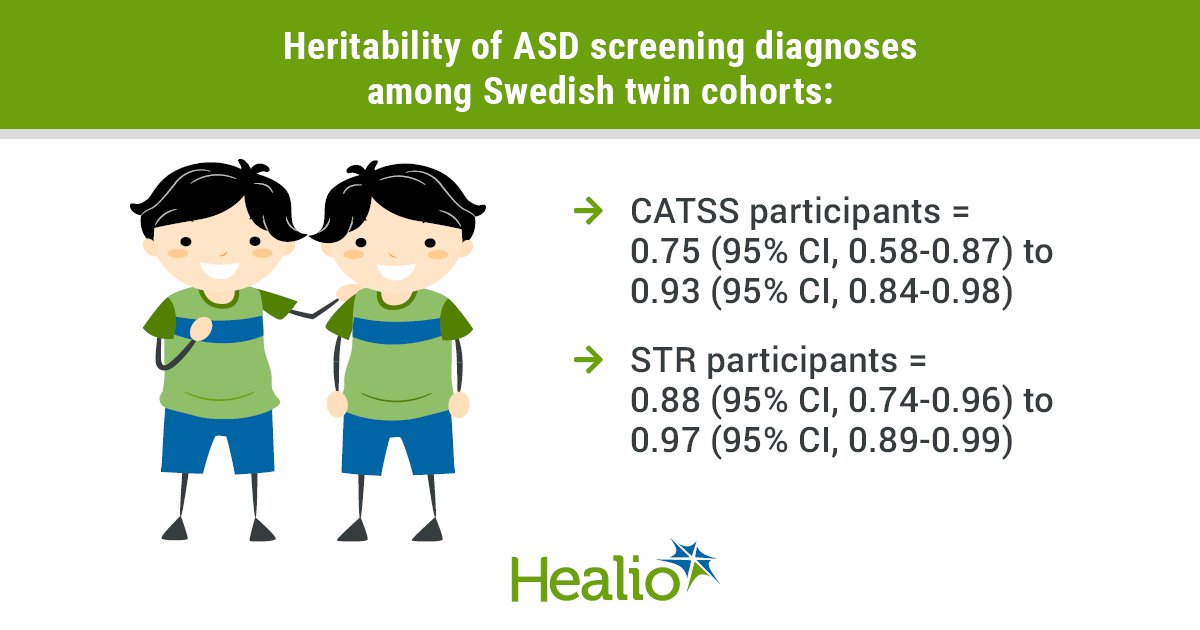Environmental factors fail to explain increased autism prevalence
Environmental factors linked to autism spectrum disorder did not increase in importance over time and thus are unlikely to explain the increase in ASD prevalence, according to results of a twin design study published in JAMA Psychiatry.
“Twin methods provide a tool for testing [the environmental] hypothesis because they can compare the magnitude of genetic and environmental contributions with a trait over different groups, such as individuals born during different periods,” Mark J. Taylor, PhD, of the department of medical epidemiology and biostatistics at Karolinska Institutet in Stockholm, and colleagues wrote. “If changes in the environment over time account for the changing prevalence of a trait, then one hypothesis is that the environmental variance would be expected to increase over time. If the underlying genetic variance showed little or no change, then one expectation is that the heritability of a given trait would also decrease.”
Taylor and colleagues aimed to assess whether this hypothesis is true for ASD by investigating whether the relative importance of environmental and genetic associations with ASD and autistic traits changed over a 16-year and 26-year period.
The researchers analyzed data from two nationwide Swedish twin cohorts — the Swedish Twin Registry (STR), which included participants born between January 1982 and December 2008, and the Child and Adolescent Twin Study in Sweden (CATSS), which included participants born between January 1992 and December 2008. They identified ASD diagnoses for twins in the STR, with follow up to 2013, and used questionnaires to assign screening diagnoses of ASD to CATSS participants and to assess autistic traits.

Taylor and colleagues divided each sample into multiple birth cohorts covering 1982 to 1991 for the STR only, as well as 1992 to 1995, 1996 to 1999, 2000 to 2003 and 2004 to 2008. They assessed whether change occurred across birth cohorts in environment and genetic variance underlying autistic traits, as well as relative contribution of genetics and environment to liability for autism.
The analysis included data of 22,678 twin pairs in the STR and 15,280 pairs in CATSS. Results showed heritability of screening diagnoses varied from 0.75 (95% CI, 0.58-0.87) to 0.93 (95% CI, 0.84-0.98) among CATSS participants and from 0.88 (95% CI, 0.74-0.96) to 0.97 (95% CI, 0.89-0.99) among STR participants. The researchers observed a modest variance increase in autistic traits over time that was associated with increases in environmental and genetic variance, with the total variance having increased from 0.95 (95% CI, 0.92-0.98) to 1.17 (95% CI, 1.13-1.21) over time.
“Our results do not dismiss a role for environmental factors in ASD and concur with prior studies suggesting that these factors are likely to be nonshared rather than shared,” the researchers wrote. “Nonshared environmental factors contribute toward differences between relatives sharing the same home (eg, birth weight in association with ASD).” – by Joe Gramigna
Disclosures: One study author reports grants from the Swedish Research Council during the conduct of the study, and another study author reports grants and personal fees from Shire/Takeda and personal fees from Evolan outside the submitted work. The other authors report no relevant financial disclosures.
